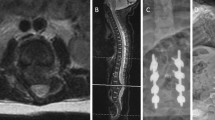Abstract
Introduction
The most challenging component of spinal dysraphism is cord tethering. Tethering can occur due to single or multiple lesions within the same patient. It is imperative to aggressively identify and release all the tethering lesions in order to provide maximum benefit to the patient. With increasing number of tethering lesions, the clinical profile and outcome show significant differences, and this difference is significantly more when more than two tethering lesions coexist in the same patient.
Material and methods
Out of the 248 patients of spinal dysraphism who underwent surgical management at Sanjay Gandhi Institute of Medical Sciences, Lucknow, India, between 1997 and 2007, 160 were included in the study. Patients were classified into two groups based on the number of tethering lesions. The first group (Group A) comprised cases of spinal dysraphism with tethering demonstrable at one or two sites. The second group (Group B) comprised patients with radiological or intraoperative evidence of multiple tethering lesions (more than two).
Results
There were 119/160 patients in Group A, while 41/160 patients were in Group B (with more than two sites of tethering). The preoperative neurological examination revealed significant differences between the two study groups. The clinical profile and the surgical outcomes have shown significant differences in the two study groups. These differences are statistically significant.
Conclusion
We strongly believe that the mere presence or absence of tethering is not a sufficient documentation to predict its effect on the cases of spinal dysraphism. Tethering is a complex entity that needs to be further classified in terms of the number of tethering lesions, which significantly affect the pre- and postoperative status of the patients. We would like to suggest the term “Spina Bifida Multiplex” for the cases where more than two lesions are found to be responsible for tethering.
Similar content being viewed by others
References
Anderson FM (1975) Occult spinal dysraphism: a series of 73 cases. Pediatrics 55:826–835
Ersahgn Y, Mutluer S, KocamanS DE (1998) Split cord malformations in children. Neurosurgery 88:57–65
Guthkelch AN (1974) Diastematomyelia with median septum. Brain 97:729–742
Hood RW, Riseborough EJ, Nehme AM, Micheli LJ, Strand RD, Neuhauser EB (1980) Diastematomyelia and structural spinal deformities. J Bone Joint Surg 62 A:520–528
Humphreys RP (1996) Spinal dysraphism. In: Rengachary SS, Wilkins RH (eds) Neurosurgery, 2nd edn. Mc Graw - Hill
Iskander BJ, Mclaughlin C, Oakes WJ (2000) Split cord malformation in myelomeningocele patients. Br J Neursurg 14(3):200–203
James CCM, Lassman LP (1962) Spinal dysraphism. The diagnosis and treatment of progressive lesions in spina bifida occulta. J Bone Joint Surg 44B:828–840
Jindal A, Mahapatra AK (2000) Split cord malformation—a clinical study of 48 cases. Indian Pediatr 37:603–607
Jindal A, Mahaptra AK, Kamal R (1999) Spinal dysraphism. Indian J Pediatr 66:697–705
Kumar R, Bansal KK, Chhabra DK (2001) Split cord malformation in pediatric patients: outcome of 19 cases. Neurol India 49:128–133
Kumar R, Singhal N (2007) Outcome of meningomyelocele/lipomeningomyelocele in children of northern India. Pediatr Neurosurg 43:7–14
McLone DG (1983) Results of treatment of children born with myelomeningocele. Clin Neurosurg 30:407–412
McLone DG (1991) Spinal dysraphism: pathogenesis and treatment. Spinal Surg 5:3–20
Mclone DG (1992) Continuing concepts in the management of spina bifida. Pediatr Neurosurg 18:254–256
Naidich TP, Raband C (1992) Congenital anomalies of the spine and the spinal cord. Rev Neuroradiol 5(suppl):113–130
Pang D, Dias MS, Ahab-barmada M (1992) Split cord malformation: Part I; unified theory of embryogenesis for double spinal cord malformation. Neurosurgery 31(3):451–480
Westcott MA, Dynes MC, Remer EM, Donaldson JS, Dias LS (1992) Congenital and acquired orthopedic abnormalities in patients with myelomeningocele. Radiographics 12:1155–1173
Author information
Authors and Affiliations
Corresponding author
Rights and permissions
About this article
Cite this article
Kumar, R., Garg, P., Kalra, S.K. et al. Management of multiple tethering in spinal dysraphism. Childs Nerv Syst 26, 1743–1747 (2010). https://doi.org/10.1007/s00381-010-1148-4
Received:
Accepted:
Published:
Issue Date:
DOI: https://doi.org/10.1007/s00381-010-1148-4




